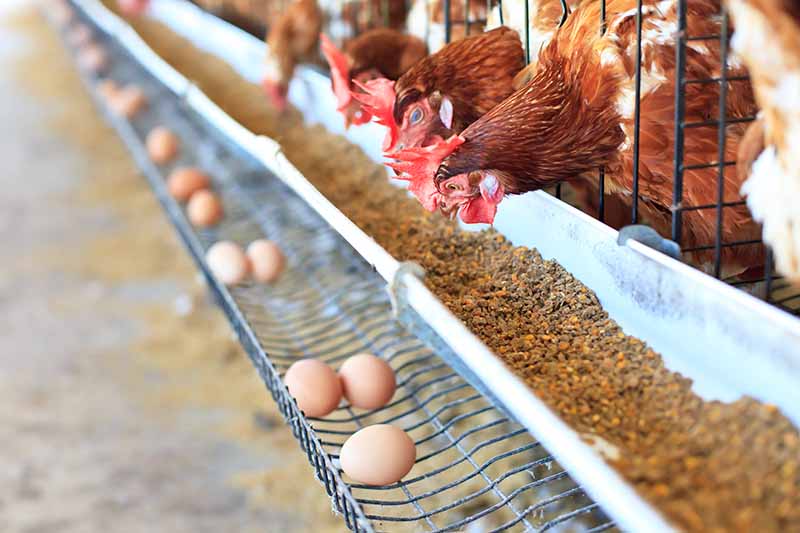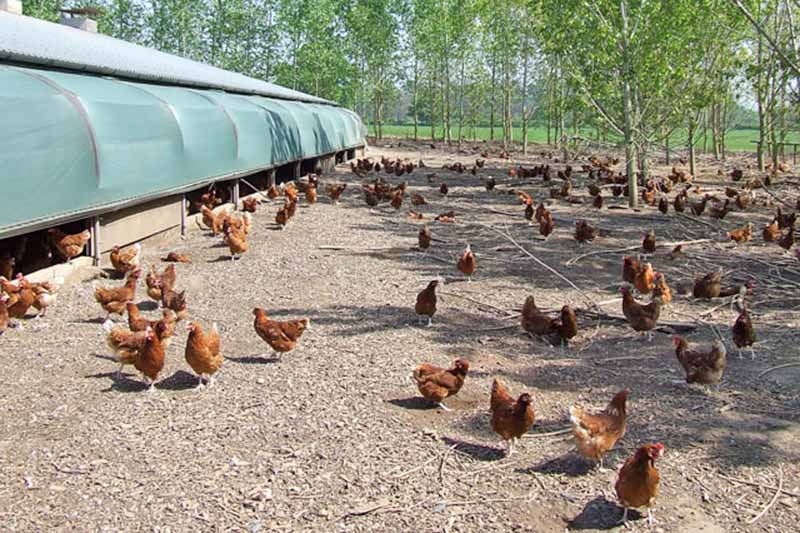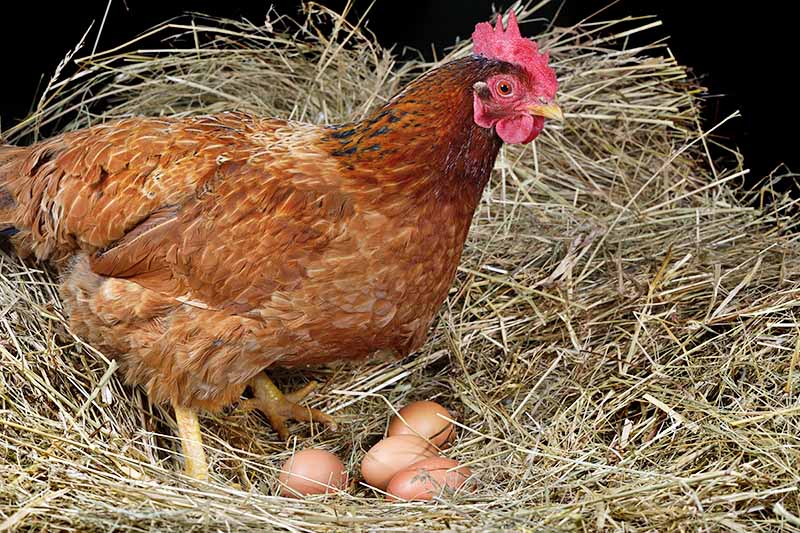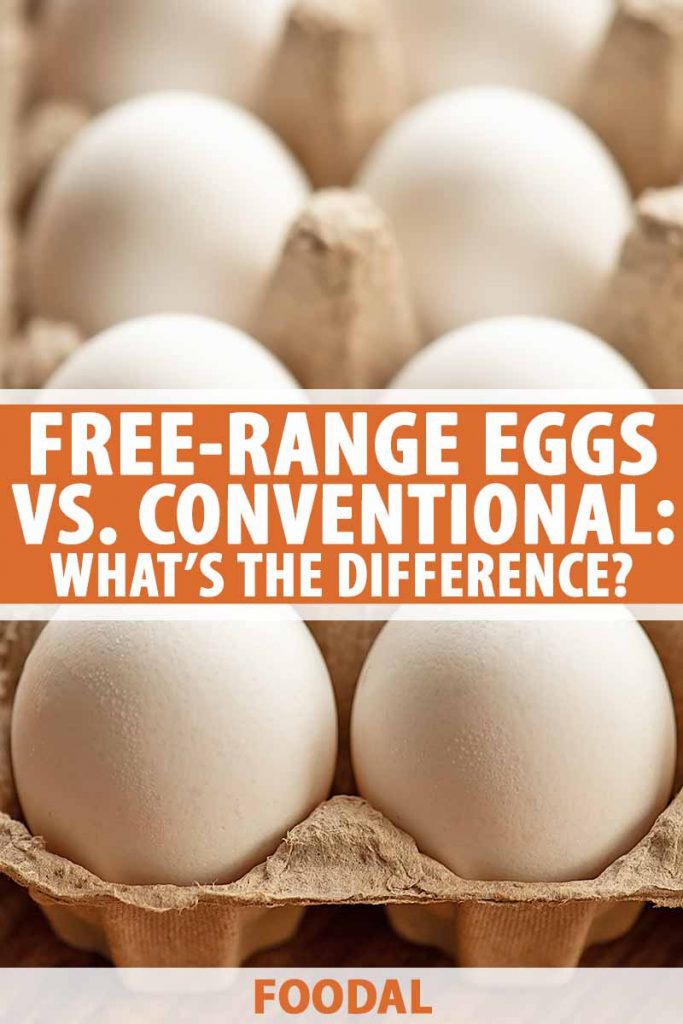Have you bought eggs lately?

If you’re like me, they’re a shopping staple. Since recipes generally call for the large size, I would always buy either the standard white-shelled dozen or an 18-count carton.
And then pandemic shortages forced me out of my comfort zone.
I investigated varieties I had never explored before with pricey alternatives for options.
Read on to find out what I learned about the differences between free-range and conventional eggs, and decide if they’re all they’re cracked up to be.
Here’s the lineup:
What’s the Difference Between Free-Range and Conventional Eggs?
Let’s get started.
What Is Free-Range?
Brace yourself for the sad story of chickens that lay in a factory setting.

Conventional eggs come from hens caged for life. They can’t walk around or spread their wings for a brief flight. They live in long compartmentalized rows called “battery cages” because they resemble an artillery installation.
The birds extend their necks through the cage bars to feed from an upper trough, and their eggs slip into a lower one, rendering the fowl immobile laying machines. Because of severe overcrowding, clipped beaks are necessary to prevent them from pecking one another to death.
More humane breeding methods include cage-free, free-range, and pasture-raised. Farmers who follow the certification requirements earn designations to display on their product labels.
In addition, the USDA grants organic certification when “uncaged” laying hens are raised on organic feed that contains no pesticides or antibiotics.
Another example of a certification is “CA-SEFS Compliant.” It’s as near a guarantee as you can get that the product is unlikely to have Salmonella enteritidis (SE) bacterium either on the surface or within the shell.
Certification and grading come under the jurisdiction of the USDA’s Agricultural Marketing Service (AMS). Grades include AA, A, and B. The first two are sold in-shell, while the inferior third type is sold in non-shell forms.

To earn free-range certification, a farm must adhere to certain humane breeding standards. Paraphrased, they include:
- A barn in which hens roam freely up, down, and sideways, although there may be multiple levels of chickens housed.
- Access to food and water.
- The ability to behave naturally, with coop bedding for nesting, as well as places to perch and scratch.
- Ongoing access to an outdoor space that may be fenced or netted.
- Safe and humane conditions and protection from predators.
To be certified humane, there must be at least two square feet of outdoor space per hen and a total of six hours per day spent outdoors. The outdoor space is not required to contain live vegetation.
Are you sensing that free-range is not as natural as it sounds?
So was I, so I looked into cage-free and pasture-raised varieties.

Cage-free sounded pleasant but is more restrictive than free-range. These hens live in a barn where they move around and lay in boxes, but never go outdoors.
Pasture-raised fowl have the most freedom to roam, with six hours of outdoor time daily, a minimum of 108 square feet per bird, and live vegetation to forage at will.
Then I saw Eggland’s Best, a brand sourced from antibiotic-free chickens fed vegetarian feed that’s rich in vitamins and omega-3 fatty acids. The company offers “classic,” which comes from conventional battery cage hens, as well as cage-free and organic products.
More humane methods, certifications, grading, and organic feed add to farmers’ production costs. They recoup them by charging more for their products than conventional farmers.
A Mixed Bag
Per the Mayo Clinic, one large egg has approximately 186 milligrams of cholesterol, and it is all found in the yolk. Their physicians make a standard recommendation to keep cholesterol intake below 300 milligrams per day for a heart-healthy diet.

The store-brand battery-cage large white eggs I was used to buying have 185 milligrams of cholesterol each, and 70 calories. Their current price in my locale is $2.85.
I learned that their brown counterparts are the same in all respects, but they are cheaper, at $2.79. Both have 6% of the daily value of vitamin D and 6% iron. There is no mention of vitamin A, indicating that it is insignificant. The fat content per serving is 5 grams.
The next closest product is cage-free white eggs. They have the same content of calories and cholesterol but a price of $3.29, with 6% vitamin D and 6% iron. Vitamin A is not mentioned, and the fat content is 5 grams.
For a free-range white option, I had to go up to $4.49 in price. That’s the cheapest I found available. And the product I chose still has 70 calories and 185 milligrams of cholesterol per serving. There is 6% of the daily value of iron in these, and no mention of vitamins A or D. The fat content is 5 grams.
Remember, the chickens that laid all three types could not supplement their diets with foraged leafy greens and protein-rich bugs found in pastures.
Then I found the only pasture-raised product on offer, brown-shelled, with 72 calories and 186 milligrams of cholesterol each. There is no mention of vitamin D, though these have 5% of the daily value of vitamin A and 5% iron.
My research to this point seems to demonstrate that regardless of breeding, eggs in the same size category have similar amounts of calories, cholesterol, vitamins, and fat contents.

A 2011 Poultry Science article describes a study that also couldn’t discern a significant nutritional advantage of free-range as compared with caged birds.
However, I then looked into classic Eggland’s Best, and we may both be wrong.
My store currently carries these for $2.79 per dozen. They have only 60 calories, 170 milligrams of cholesterol, a whopping 30% vitamin D, and 4 grams of fat per egg.
I bought them.
The eggs were of uniform size, the shells were firm, the yolks were a bright yellow-orange, and the sell-by date was weeks away. And, I noticed no fishy odor from the omega-3s in the vegetarian chicken feed. They tasted good.
In my experience, this is undoubtedly the best of the conventional products I’ve used to date. And I don’t doubt there are others, so read labels and experiment.
At the Market
When shopping in person, it’s easy to read product labels and compare ingredients like calories and cholesterol when you’re buying eggs. Be sure to look inside the lid of the carton if you can’t find this info.

While many online grocery sites offer ingredient lists and photos of the tops and sides of the carton, inaccuracies abound.
One example is an online write-up I found for “Free-Range Pasture-Raised Eggs.” A close examination of the product label revealed that it was strictly free-range.
And while these distinctions may seem trivial, the price differences are not, nor is the guilt induced by knowing how many commercial chickens live.
The Chickens and the Eggs
To recap, free-range eggs come from hens with a better quality of life than conventional battery-cage fowl. They have the ability to move around indoors, and have outdoor time with two feet of space per bird and no requirement for available forage.

However, they do not enjoy the physical space, exercise, leafy forage, and protein-rich insects of pasture-raised birds.
There is not always a significant variation in the nutritional content of free-range and conventional eggs. Still, at least one company I learned about offers conventional or “classic” eggs that stand out for their exceptional quality and significantly higher vitamin D content.
Here are a few final considerations:
Fresh and local products may be a better choice than your typical store-bought ones that have endured a long journey to market and many days on store shelves. However, many of us lack access to reliable sources. Read sell-by dates and choose the freshest available.
Look inside the cartons. Don’t purchase those with wet residue or dirt on the shell surfaces, as this may serve to harbor pathogens.
And finally, remember to compare eggs of the same size when making your selections, and look for quantity discounts, such as buying 18 instead of 12.
What are your thoughts on eggs?
Let us know in the comments section below.
Please visit Foodal often for more egg articles and recipes if you want to have fun and mix up how you cook them, starting with these:
- 5 Spectacular Ways to Use Up Leftover Yolks
- Gluten-Free Super Veggie Breakfast Scramble
- Don’t Stress During Brunch with This Easy Overnight Egg Bake
© Ask the Experts, LLC. ALL RIGHTS RESERVED. See our TOS for more details. Credited Photos: Wikimedia Commons. Uncredited photos: Shutterstock.
About Nan Schiller
Nan Schiller is a writer from southeastern Pennsylvania. When she’s not in the garden, she’s in the kitchen preparing imaginative gluten- and dairy-free meals. With a background in business, writing, editing, and photography, Nan writes humorous and informative articles on gardening, food, parenting, and real estate topics. Having celiac disease has only served to inspire her to continue to explore creative ways to provide her family with nutritious locally-sourced food.




